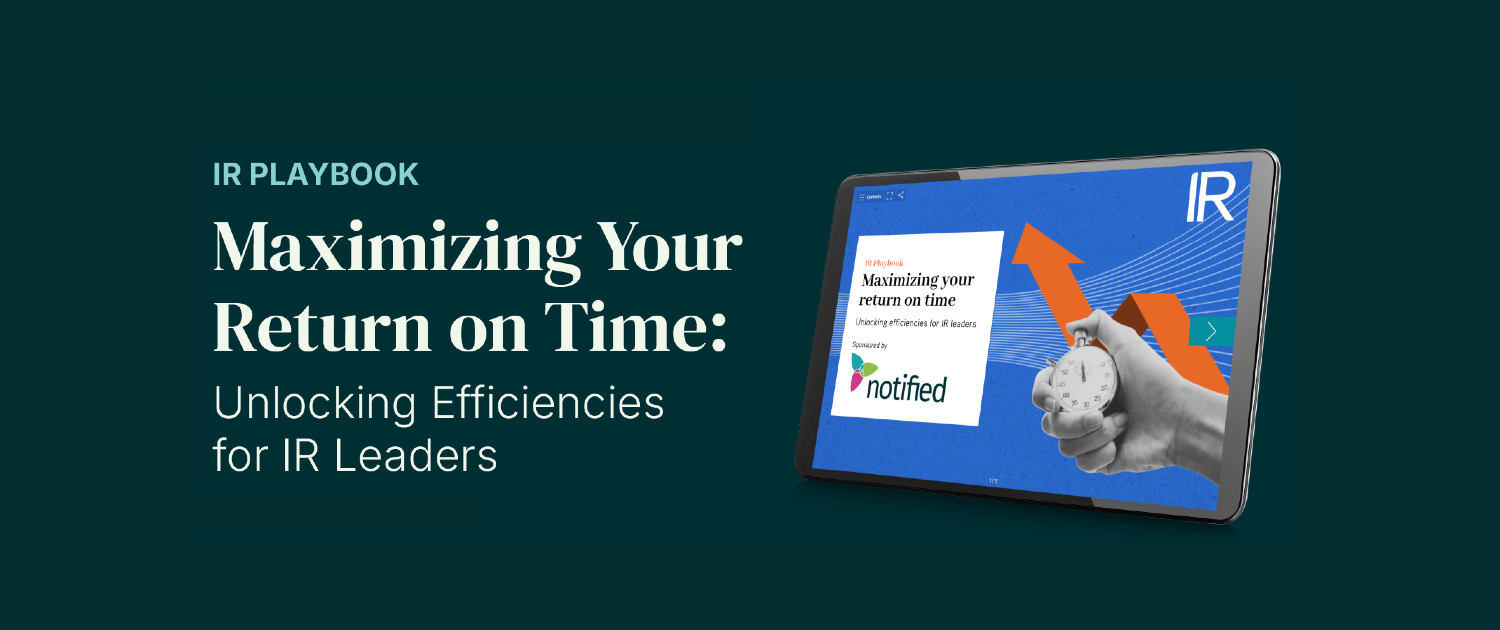Share this
8 Ways To Improve IR Website Accessibility
by The Notified Team on May 9, 2024 7:23:57 PM
In the world of investor relations, your IR website is the first point of contact. Therefore, your site must be informative, user-friendly and inclusive to all individuals - regardless of their abilities.
The mantra of inclusivity - ensuring equal rights and access for everyone - echoes loudly in today's society. It's not just a moral obligation; it's a strategic imperative. This is especially true in IR, where accessibility can make or break crucial investment decisions (as well as bring about litigation).
The most effective IR websites actively implement international guidelines to ensure they meet accessibility requirements. This approach gives equal opportunity to everyone to engage and invest in the future of your company.
But what exactly is web accessibility? And how can you make your IR website more inclusive?

What Is Web Accessibility? Why Does It Matter?
Web accessibility refers to the design and development of websites that are usable by everyone, regardless of their abilities. This includes people with disabilities such as vision impairment, hearing loss, motor impairments and cognitive disabilities.
"The power of the web is in its universality. Access by everyone regardless of disability is an essential aspect," said Tim Berners-Lee, W3C Director and inventor of the World Wide Web.
For IR websites, accessibility is not just about being inclusive - it's also about smart business. Here's why:
- Wider Audience Reach: A well-designed, accessible IR website can be accessed by a broader range of investors, including those with disabilities. This can lead to increased investment opportunities and a stronger investor base.
- Enhanced Brand Reputation: By prioritizing accessibility, you demonstrate your commitment to diversity and inclusion, which can positively impact your brand image.
- Legal Compliance: Many countries have laws and regulations that mandate website accessibility. Lawsuits aimed at companies that don't meet accessibility standards are happening more often, and getting results.
IR sites that prioritize digital accessibility hold a distinct advantage over those that do not. And these accessibility requirements must follow global guidelines.
What Are Web Content Accessibility Guidelines (WCAG)?
Web Content Accessibility Guidelines (WCAG) are a set of standards developed by the World Wide Web Consortium (W3C) to ensure that web content is accessible to people with disabilities.
These guidelines provide a framework for making web content more usable for individuals with various impairments - including visual, auditory, physical, speech, cognitive, language, learning and neurological disabilities.
WCAG outlines four principles of accessibility:
- Perceivable
- Operable
- Understandable
- Robust
WCAG also provides specific guidelines and success criteria for each principle. These guidelines cover various aspects of web content - including text alternatives for non-text content, keyboard accessibility, color contrast, clear navigation and compatibility with assistive technologies.
In essence, WCAG serves as a blueprint for creating websites and web applications that are accessible to all users, regardless of their abilities or disabilities.
Using these guidelines, we offer eight ways to improve your IR website accessibility.
8 Ways To Improve IR Website Accessibility
There are multiple steps you can take, by including:
1. Clear and Simple Navigation
Make sure your website has a clear and logical structure with a well-defined navigation system. Users should be able to find the information they need within three clicks. Consider using a sitemap to provide a visual overview of your website's content.
2. Mobile-Friendly Design
A significant portion of users will access your website from mobile devices. Ensure your IR website is responsive and optimized for mobile browsing.
3. Keyboard Accessibility
Your website should be fully functional using just the keyboard. This allows users who rely on screen readers or have difficulty using a mouse to navigate and interact with your website.
4. Use of Color and Contrast
Ensure adequate color contrast between text and background for readability. People with visual impairments may struggle with low contrast. Tools are available online to check your website's color contrast ratio.
5. Alternative Text Descriptions
Provide alternative text descriptions for images and other non-text content. This allows screen readers to convey the meaning of the content to visually impaired users.
6. Plain Language
Use clear and concise language that is easy to understand for a broad audience. Avoid using overly technical jargon or acronyms without explanation.
7. Multiple File Formats
Offer important documents like financial statements and presentations in multiple downloadable formats, including HTML and accessible PDF. This allows users with different assistive technologies to access the information.
8. Transcripts and Closed Captions
Provide transcripts for audio and video content (including earning webcasts and calls) and closed captions for videos. This benefits users who are deaf or hard of hearing. This allows people with hearing impairments to follow along with the video content.
Note: Some screen readers include: JAWS, NVDA, Narrator and VoiceOver.
By following these best practices, you can create an investor relations website that is accessible to everyone, regardless of ability.
This will not only improve your company’s image, but also ensure that all investors have equal access to the information they need to make informed decisions.
Notified: Your Partner for Accessible IR Websites
Why should you trust Notified as your IR website partner?
- Best-in-class, modern design
- Enterprise-level security
- 3,100+ IR websites hosted
- 24/7/365 service and support
- Experienced in-house team
- Complete services for earnings and investor communications
Contact us today to learn more!

Why Does AI Prefer Press Releases?

What’s Changed in Investor Relations - And What You Need to Do Next

Press Release Distribution 101: Frequently Asked Questions
Share this
- Public Relations (219)
- Press Releases (115)
- Press Release Distribution (91)
- GlobeNewswire (87)
- Investor Relations (84)
- PR Communications (72)
- Artificial Intelligence (70)
- Media Relations (47)
- IR Communications (39)
- Media Contacts Database (38)
- Global News Distribution (32)
- Webinar (30)
- IR Websites (28)
- Earnings Calls (22)
- Notified PR Platform (21)
- IR Webcasts (19)
- Experiences (17)
- Studio Webinar Platform (17)
- Virtual Events (17)
- Writing Tips (17)
- PR Trends (16)
- Webcasts (16)
- PR Measurement (15)
- Case Study (14)
- Generative AI (13)
- Media Monitoring (13)
- Event Technology (12)
- Investor Days (12)
- Webinar Strategy (12)
- ESG (10)
- Social Media (10)
- IR Event Platform (9)
- Newswire (9)
- Virtual Event Platform (9)
- Accessibility (8)
- Earnings Day (8)
- Earnings Release (8)
- News Roundup (8)
- Regulatory Filing (8)
- United Kingdom (8)
- Germany (6)
- Report (6)
- Social Listening (6)
- CLEAR Verified (5)
- IR Hub (5)
- Video (5)
- Webinar Engagement (5)
- Brand Storytelling (4)
- Misinformation (4)
- PR Agency (4)
- SEO (4)
- Trust (4)
- IR Trends (3)
- Journalism (3)
- AGM (2)
- Awards (2)
- Branding (2)
- CSR (2)
- DEI (2)
- Demand Generation (2)
- Insights & Analytics (2)
- ROI (2)
- Sentiment Analysis (2)
- Webhosting (2)
- Annual General Meeting (1)
- Canada (1)
- Emojis (1)
- Equiniti (1)
- Events (1)
- Halloween (1)
- Internal Communications (1)
- Internships (1)
- Life At Notified (1)
- Mark Cuban Foundation AI Bootcamp (1)
- Marketing (1)
- News Briefs (1)
- News Releases (1)
- PRSA ICON (1)
- Product Launch (1)
- Retail Investors (1)
- SXSW (1)
- Share of Voice (1)
- Sponsorships (1)
- Success Story (1)
- White Paper (1)
- eBook (1)
- July 2025 (9)
- June 2025 (12)
- May 2025 (9)
- April 2025 (11)
- March 2025 (11)
- February 2025 (6)
- January 2025 (12)
- December 2024 (12)
- November 2024 (12)
- October 2024 (14)
- September 2024 (15)
- August 2024 (14)
- July 2024 (14)
- June 2024 (14)
- May 2024 (12)
- April 2024 (13)
- March 2024 (13)
- February 2024 (15)
- January 2024 (11)
- December 2023 (7)
- November 2023 (13)
- October 2023 (14)
- September 2023 (7)
- August 2023 (8)
- July 2023 (7)
- June 2023 (8)
- May 2023 (8)
- April 2023 (5)
- March 2023 (5)
- February 2023 (8)
- January 2023 (9)



